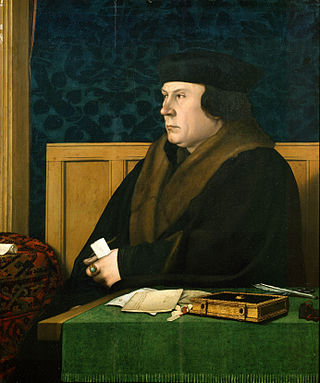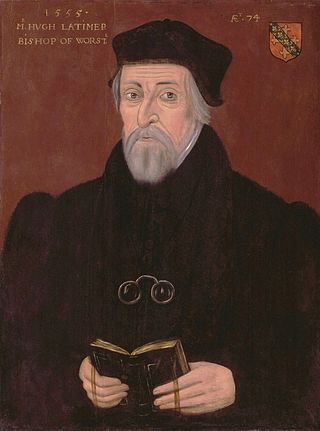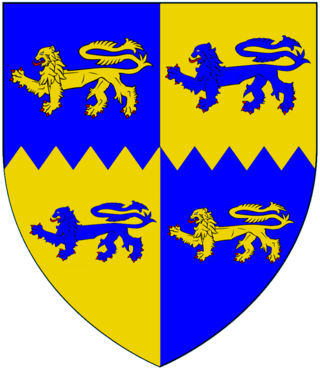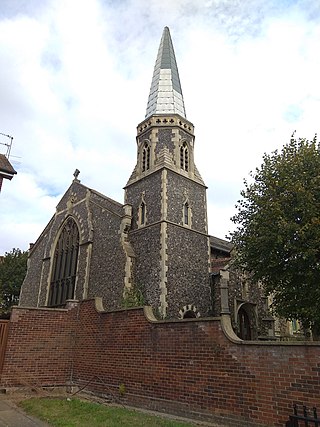Related Research Articles

Thomas Cranmer was a theologian, leader of the English Reformation and Archbishop of Canterbury during the reigns of Henry VIII, Edward VI and, for a short time, Mary I. He is honoured as a martyr in the Church of England.

Thomas Cromwell, briefly Earl of Essex, was an English statesman and lawyer who served as chief minister to King Henry VIII from 1534 to 1540, when he was beheaded on orders of the king, who later blamed false charges for the execution.

Hugh Latimer was a Fellow of Clare College, Cambridge, and Bishop of Worcester during the Reformation, and later Church of England chaplain to King Edward VI. In 1555 under the Catholic Queen Mary I he was burned at the stake, becoming one of the three Oxford Martyrs of Anglicanism.

John Foxe was an English clergyman, theologian, and historian, notable for his martyrology Actes and Monuments, telling of Christian martyrs throughout Western history, but particularly the sufferings of English Protestants and proto-Protestants from the 14th century and in the reign of Mary I. The book was widely owned and read by English Puritans and helped to mould British opinion on the Catholic Church for several centuries.

Edwin Sandys was an English prelate. He was Anglican Bishop of Worcester (1559–1570), London (1570–1576) and Archbishop of York (1576–1588) during the reign of Elizabeth I of England. He was one of the translators of the Bishops' Bible.
John de Vere, 16th Earl of Oxford was born to John de Vere, 15th Earl of Oxford and Elizabeth Trussell, daughter of Edward Trussell. He was styled Lord Bolebec 1526 to 1540 before he succeeded to his father's title.

Thomas Wentworth, 2nd Baron Wentworth was an English peer, courtier, administrator and military commander during the reigns of Edward VI, Mary I and Elizabeth I. His reputation suffered through the surrender of Calais in 1558, which occurred under his command.
Henry Cole was a senior English Roman Catholic churchman and academic.
Juan de Villagarcía was a Spanish Dominican from Valladolid, known as the witness to one of the statements of confession and recantation by Thomas Cranmer.

Henry Cromwell, 2nd Baron Cromwell, the son of Gregory Cromwell, 1st Baron Cromwell and Elizabeth Seymour, was an English peer during the reign of Elizabeth I. He was the grandson of Henry VIII's chief minister, Thomas Cromwell, 1st earl of Essex, nephew of the Protector Somerset and first cousin of Edward VI.
William Latymer or Latimer (1499–1583) was an English evangelical clergyman, Dean of Peterborough from 1560. He was chaplain to Anne Boleyn, and is best known for his biography of her, the Chronickille of Anne Bulleyne.
John Walker D.D. was an English churchman, archdeacon of Essex from 1571.
John Dakyn was an English cleric and historian. He was Archdeacon of the East Riding of Yorkshire and a noted chronicler of the Pilgrimage of Grace.

The Stratford Martyrs were eleven men and two women who were burned at the stake together for their Protestant beliefs, either at Stratford-le-Bow, Middlesex or Stratford, Essex, both near London, on 27 June 1556 during the Marian persecutions.
Thomas Poley, of London and Ware, Hertfordshire was an English politician. He was a Member of Parliament (MP) for Melcombe Regis in 1545, Ipswich in April 1554 and Ripon in 1555.
Thomas Martin (1521-1593), of Winterbourne St. Martin, Dorset; Steeple Morden, Cambridgeshire, and London, was an English lawyer, controversialist and politician. He was prominent in the trial of Thomas Cranmer.
James Calfhill was an Anglican priest, academic and controversialist, who died as Archdeacon of Colchester and Bishop-designate of Worcester.
Roger Kelke (1524–1576) was an English churchman and academic, a Marian exile and Master of Magdalene College, Cambridge from 1558 and Archdeacon of Stow from 1563.

St Helen's Church, Ipswich is an Anglican church in Ipswich, Suffolk, England. The church is built from knapped flint rubble with additional stone and white brick dressings. Although some of the building dates back to the medieval period, the building was substantially altered in the nineteenth century.
Thomas Some or Solme was an English Protestant divine. An unwilling monk, he took up advanced Protestant views and was an active preacher under Edward VI, but probably fled abroad on Mary's accession. His treatise, the Lord's Flail, was burned by Bonner in 1546.
References
- ↑ "Argentine, Richard (alias Sexten) (ARGN540R)". A Cambridge Alumni Database. University of Cambridge.
- ↑ Whitelock, Anna; MacCulloch, Diarmaid (2007). "Pincess Mary's Household and the Succession Crisis, July 1553" (PDF). The Historical Journal. 50 (2): 265–287. doi:10.1017/S0018246X07006061. ISSN 0018-246X. JSTOR 4140130. S2CID 161366294.
- ↑ "Learning Arabic in England". Muslim Museum. Muslim Museum Initiative. Retrieved 15 September 2020.
- ↑ Gerald J. Toomer, G. J. (1996). Eastern Wisedome and Learning: The Study of Arabic in Seventeenth-century England. Oxford: Clarendon Press. ISBN 978-0-19-820291-2.
- ↑ MacCulloch, Diarmaid; Blatchly, John (1991). "Pastoral Provision in the Parishes of Tudor Ipswich" (PDF). The Sixteenth Century Journal. 22 (3): 457–474. doi:10.2307/2541470. ISSN 0361-0160. JSTOR 2541470.
- ↑ Foxe, John (1563). Foxe's Book of Martyrs.
- ↑ Cooper 1885.
- Attribution
![]() This article incorporates text from a publication now in the public domain : Cooper, Thompson (1885). "Argentine, Richard". In Stephen, Leslie (ed.). Dictionary of National Biography . Vol. 2. London: Smith, Elder & Co.
This article incorporates text from a publication now in the public domain : Cooper, Thompson (1885). "Argentine, Richard". In Stephen, Leslie (ed.). Dictionary of National Biography . Vol. 2. London: Smith, Elder & Co.